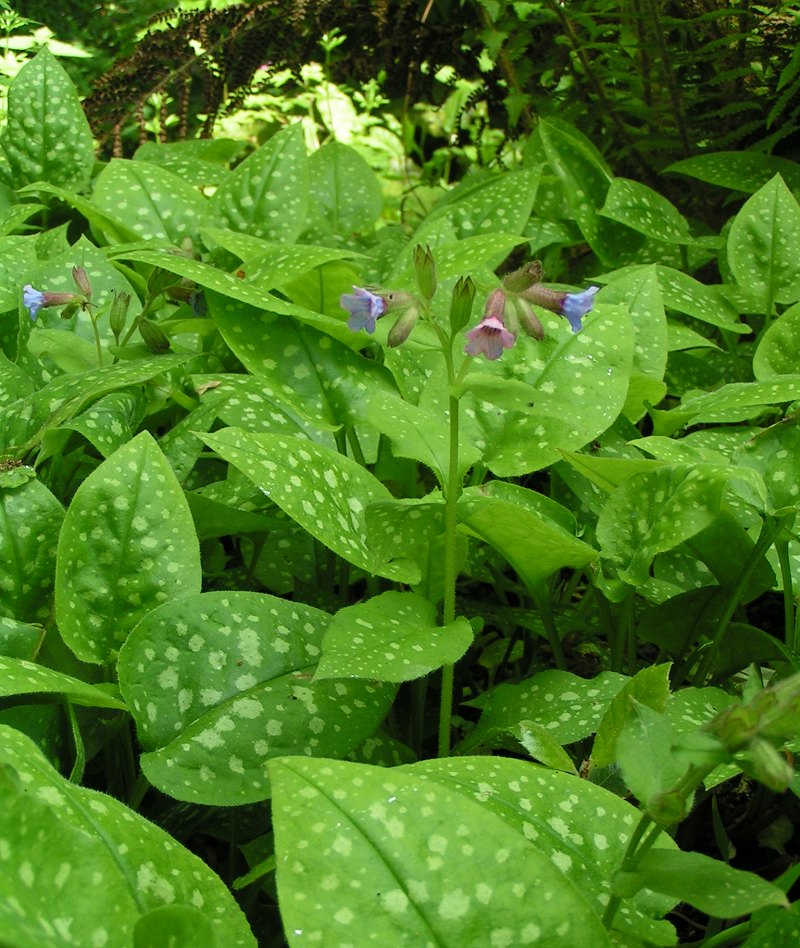- Pulmonaria
image_width = 240px
image_caption = "Pulmonaria officinalis"
regnum =Plant ae
divisio =Magnoliophyta
classis =Magnoliopsida
ordo =Lamiales
familia =Boraginaceae
genus = "Pulmonaria"
genus_authority = L.
subdivision_ranks = Species
subdivision = "Pulmonaria affinis "
"Pulmonaria angustifolia "
"Pulmonaria filarszkyana "
"Pulmonaria kerneri "
"Pulmonaria longifolia "
"Pulmonaria mollis "
"Pulmonaria mollissima "
"Pulmonaria montana "
"Pulmonaria obscura "
"Pulmonaria officinalis "
"Pulmonaria rubra "
"Pulmonaria saccharata "
"Pulmonaria stiriaca "
"Pulmonaria vallarsae "
"Pulmonaria visianii "The lungworts are the
genus "Pulmonaria" offlowering plant s in the familyBoraginaceae , native toEurope and westernAsia , with one species ("P. mollissima") east to central Asia. According to various estimates there may be between 10 and 18 Pulmonaria species found in the wild, but the taxonomy of this genus is very confusing.The scientific name "Pulmonaria" is derived from Latin "pulmo" (the lung). In the times of
sympathetic magic , the spotted oval leaves of "P. officinalis" were thought to symbolize diseased, ulcerated lungs, and so were used to treat pulmonary infections. The common name in many languages also refers to lungs, as in English "lungwort" and German "Lungenkraut". In some East European languages, the common name is derived from a word for honey, e.g. Russian "medunitza" and Polish "miodunka".English colloquial names include Lungwort, Soldiers and Sailors, Spotted dog, Joseph and Mary, Jerusalem Cowslip, Bethlehem Sage.
Description
Lungworts are perennial herbs that form clumps or rosettes. They are covered in hairs of varied length and stiffness, and sometimes also bear
glands .The underground parts consist of a slowly creepingrhizome with adventitious roots. Flowering stems are unbranched, rough, covered with bristly hairs, usually not exceeding 25–30cm, with a few exceptions ("P. mollis, P. vallarsae"). The stems are usually upright, or slightly spreading.The leaves are arranged in rosettes. The blades are usually large, from narrowly lanceolate to oval, with the base ranging from heart shaped to very gradually narrowing, and can have a sharply pointed or blunt tip. Leaf margin is always entire, but in some species and forms can be rather wavy. Basal leaves are carried on stalks that can be short or longer than the leave blade in various species. Stem leaves are smaller and often narrower, and are unstalked or clasping the stem. All leaves are covered with hairs that are usually bristly, or occasionally soft. The leaves are often prominently spotted in black and blue, or sometimes in pale green, or unspotted.
The
inflorescence is a terminal scorpioidcyme , withbracts . Lungwort flowers are heterostylous, with two distinct forms of flower within each species; those with short stamens and long styles ("pin" flowers) and those with long stamens and short styles ("thrum" flowers), with the former usually being larger and more showy. The calyx is hairy, 5-lobed, tubular or funnel-shaped, enlarging as the fruit ripens. The corolla is funnel-shaped and consists of a long, cylindrical tube and a limb with five shallow lobes. Within the corolla throat, five tufts of hairs alternate with the stamens to form a ring. The colour of corolla varies from purple, violet or blue to shades of pink and red, or sometimes white. The colour of the flower in bud is often pink, which then changes as the flower matures. Thestamens and style are included within the corolla and not protruding.The
nutlet s are smooth, egg-shaped, brownish, up to 4.5 mm long and 3 mm wide, each containing a single seed. Up to four nutlets per flower are produced, ripening mostly in summer."Pulmonaria" species are used as food plants by the
larva e of someLepidoptera species including "Coleophora pulmonariella" which feeds exclusively on "P. saccharata".References
* [http://rbg-web2.rbge.org.uk/cgi-bin/nph-readbtree.pl/feout?FAMILY_XREF=&GENUS_XREF=Pulmonaria+&SPECIES_XREF=&TAXON_NAME_XREF=&RANK=species Flora Europaea: "Pulmonaria"]
* [http://www.efloras.org/florataxon.aspx?flora_id=2&taxon_id=127635 Flora of China: "Pulmonaria"]
* Bennett, M. (2003) [http://www.batsford.co.uk/book/0713487321 "Pulmonarias and the Borage Family"] . B.T.Batsford, 240pp. ISBN 0-7134-8732-1
* Hewitt, J. (1994). "Pulmonarias". Hardy Plant Society, 51pp. ISBN 0-901687-10-3
Wikimedia Foundation. 2010.

